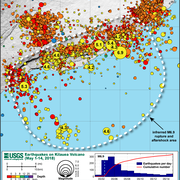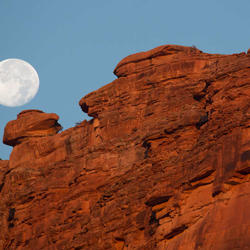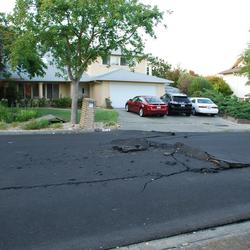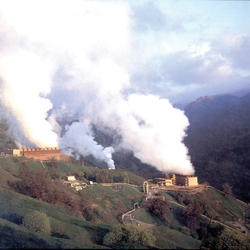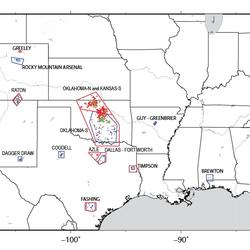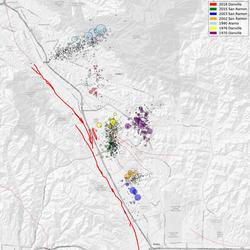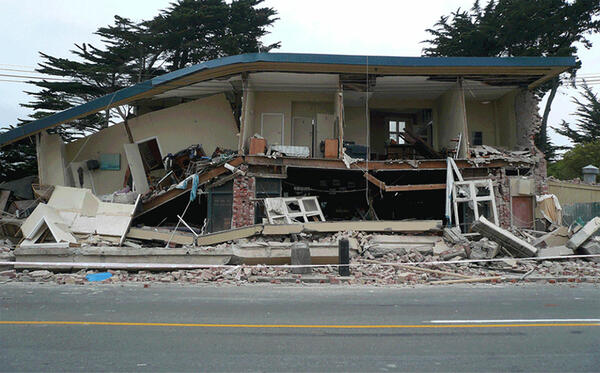If you were to stand on the fault and look along its length, this is a type of strike-slip fault where the right block moves toward you and the left block moves away.
What is an earthquake and what causes them to happen?
An earthquake is caused by a sudden slip on a fault. The tectonic plates are always slowly moving, but they get stuck at their edges due to friction. When the stress on the edge overcomes the friction, there is an earthquake that releases energy in waves that travel through the earth's crust and cause the shaking that we feel.
In California there are two plates - the Pacific Plate and the North American Plate. The Pacific Plate consists of most of the Pacific Ocean floor and the California Coast line. The North American Plate comprises most the North American Continent and parts of the Atlantic Ocean floor. The primary boundary between these two plates is the San Andreas Fault. The San Andreas Fault is more than 650 miles long and extends to depths of at least 10 miles. Many other smaller faults like the Hayward (Northern California) and the San Jacinto (Southern California) branch from and join the San Andreas Fault Zone.
The Pacific Plate grinds northwestward past the North American Plate at a rate of about two inches per year. Parts of the San Andreas Fault system adapt to this movement by constant "creep" resulting in many tiny shocks and a few moderate earth tremors. In other areas where creep is NOT constant, strain can build up for hundreds of years, producing great earthquakes when it finally releases.
Learn More: Glossary of earthquake terms
Related
Foreshocks, aftershocks - what's the difference?
Can the position of the moon or the planets affect seismicity? Are there more earthquakes in the morning/in the evening/at a certain time of the month?
What is surface faulting or surface rupture in an earthquake?
At what depth do earthquakes occur? What is the significance of the depth?
Why are there so many earthquakes in the Geysers area in Northern California?
Do earthquakes occur in Antarctica?
Where can I find earthquake educational materials?
Can we cause earthquakes? Is there any way to prevent earthquakes?
What is the difference between aftershocks and swarms?
If you were to stand on the fault and look along its length, this is a type of strike-slip fault where the right block moves toward you and the left block moves away.
Diagram of left-lateral motion on fault. If you were to stand on the fault and look along its length, this is a type of strike-slip fault where the left block moves toward you and the right block moves away. See also right-lateral.
Diagram of left-lateral motion on fault. If you were to stand on the fault and look along its length, this is a type of strike-slip fault where the left block moves toward you and the right block moves away. See also right-lateral.
Horst and graben diagram. A graben is a down-dropped block of the earth's crust resulting from extension, or pulling, of the crust.
Horst and graben diagram. A graben is a down-dropped block of the earth's crust resulting from extension, or pulling, of the crust.
Subduction zone of the Juan de Fuca Plate and North America Plate, creating the Mt. St. Helens and Mt. Hood volcanoes.
Subduction zone of the Juan de Fuca Plate and North America Plate, creating the Mt. St. Helens and Mt. Hood volcanoes.
Building damanged by the February 2011 earthquake in Christchurch, New Zealand.
Building damanged by the February 2011 earthquake in Christchurch, New Zealand.
Oblique aerial view of San Andreas Fault (between white arrows) in southeastern Coachella Valley, near Red Canyon; view to the west.
Oblique aerial view of San Andreas Fault (between white arrows) in southeastern Coachella Valley, near Red Canyon; view to the west.
U.S. Geological Survey Earthquake Hazards Program decadal science strategy, 2024–33
Natural Hazards Science at the U.S. Geological Survey
Earthquake hazards: A national threat
Quaternary Fault and Fold Database for the Nation
The severity of an earthquake
This dynamic earth: the story of plate tectonics
The interior of the earth
Our changing continent
Related
Foreshocks, aftershocks - what's the difference?
Can the position of the moon or the planets affect seismicity? Are there more earthquakes in the morning/in the evening/at a certain time of the month?
What is surface faulting or surface rupture in an earthquake?
At what depth do earthquakes occur? What is the significance of the depth?
Why are there so many earthquakes in the Geysers area in Northern California?
Do earthquakes occur in Antarctica?
Where can I find earthquake educational materials?
Can we cause earthquakes? Is there any way to prevent earthquakes?
What is the difference between aftershocks and swarms?
If you were to stand on the fault and look along its length, this is a type of strike-slip fault where the right block moves toward you and the left block moves away.
If you were to stand on the fault and look along its length, this is a type of strike-slip fault where the right block moves toward you and the left block moves away.
Diagram of left-lateral motion on fault. If you were to stand on the fault and look along its length, this is a type of strike-slip fault where the left block moves toward you and the right block moves away. See also right-lateral.
Diagram of left-lateral motion on fault. If you were to stand on the fault and look along its length, this is a type of strike-slip fault where the left block moves toward you and the right block moves away. See also right-lateral.
Horst and graben diagram. A graben is a down-dropped block of the earth's crust resulting from extension, or pulling, of the crust.
Horst and graben diagram. A graben is a down-dropped block of the earth's crust resulting from extension, or pulling, of the crust.
Subduction zone of the Juan de Fuca Plate and North America Plate, creating the Mt. St. Helens and Mt. Hood volcanoes.
Subduction zone of the Juan de Fuca Plate and North America Plate, creating the Mt. St. Helens and Mt. Hood volcanoes.
Building damanged by the February 2011 earthquake in Christchurch, New Zealand.
Building damanged by the February 2011 earthquake in Christchurch, New Zealand.
Oblique aerial view of San Andreas Fault (between white arrows) in southeastern Coachella Valley, near Red Canyon; view to the west.
Oblique aerial view of San Andreas Fault (between white arrows) in southeastern Coachella Valley, near Red Canyon; view to the west.


